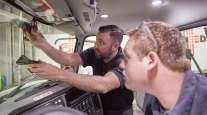iTECH: Insurers Are Not Swayed by Safety Devices
This article appears in the December 2011/January 2012 issue of iTECH, published in the Dec. 12 print edition of Transport Topics. Click here to subscribe today.
An ever-increasing number of fleets today are investing significant capital to outfit their trucks with the latest safety technology to reduce accidents that harm people and disrupt freight operations.
While one of the goals of these investments is to reduce operating costs, these fleets are discovering that installing the equipment is no guarantee that they will receive a break on insurance premiums, according to several insurers and trucking executives.
“All they really want to see is experience,” Bert Mayo said of insurance companies and brokers. Mayo, vice president and fleet specialist in risk services for Denver-based insurance broker Lockton Cos., said a fleet must tell “a great story,” specifically documenting reduced frequency of accidents as well as decreased average cost per accident.
Simply investing in technology that warns of potential collisions or lane changes, or helps prevent loss of stability, will not prompt insurers to reduce premiums, Mayo said.
“At the lower deductibles, [insurers] really look at the loss history and determine pricing from that,” he said.
A motor carrier might get some credit or discount by investing in accident technology, but the true savings will come in subsequent years as their collision-related losses are reduced, Mayo said.
“The proof is in the pudding, not in a promise,” he said.
Mayo said another hurdle is that trucking insurance is “so expensive [that] motor carriers shop for it annually.” And for that reason, he said, an underwriter may be reluctant to offer an immediate discount when, a year later, the customer might move to a different insurer.
Offering a specific discount for a specific safety technology is not the practice in insurance, but a fleet’s investment in safety technology will be included as “part of overall rate development,” said Larry Loving, managing director for broker Aon Risk Services South. He said if a safety system doesn’t show results, “on renewal there will be a frank discussion” — a review of the system.
Still, insurers are eager to hear about safety technology being installed, “and often give subjective discounts to the right trucking companies,” said David Mitchell, safety and loss prevention director for Aon Truck Group. Those are companies with “great financials and good [Compliance, Safety, Accountability] scores and good loss history,” he said. CSA scores are determined by the Federal Motor Carrier Safety Administration.
But generally, insurers tend to steer clear of specific discounts for safety technology purchased by trucking companies, Mitchell said.
“When you purchase homeowner’s insurance, there are usually specific discounts for deadbolt locks or alarm systems — mostly because those insurers have some statistical proof that those things reduce theft and vandalism,” Mitchell said. “But safety technology on trucks is different because the technology doesn’t take the place of the driver’s skills or habits.”
Because drivers’ habits remain a crucial factor in crashes, Mitchell said, “Insurers haven’t gotten to a place where they’re offering a real schedule of discounts for that stuff.”
Thom C. Pronk, vice president of recruiting, training and safe driving at Salt Lake City-based C.R. England Inc., said he thinks that will change. The motor carrier has used roll-stability control systems since 2006, and in 2008, it began implementing Mobileye technology, which incorporates warnings for lane departure, forward collision and following distance in one package. He said Mobileye systems are now on approximately 3,400 of its 4,200 trucks.
Asked how insurers have responded to C.R. England’s investments in accident-avoidance technology, Pronk replied: “They are always very happy to hear that we’re being forward thinking with technology. It’s exciting for them, something they take pleasure in. [However,] I can’t say that we’ve had rates change” as a direct result of that investment.
Yet, insurers and regulators are likely to acknowledge the benefits of accident-avoidance technology down the road, Pronk said.
“A lot of the technologies we’re talking about are becoming much more mainstream,” he said. “They’re not just a flash in the pan; they’re things that have been studied by [the American Transportation Research Institute] and other organizations. I think the insurance industry is going to take note of that.”
Accident-avoidance systems are also getting more attention from regulators, Pronk said.
FMCSA Administrator Anne Ferro “understands the technology as well as anybody,” he said.
At the same time, an effort to include an incentive in the next federal highway bill is continuing. Pronk said C.R. England is involved in lobbying for a tax benefit for trucking companies that invest in accident-avoidance technology.
“The language has been in the highway bill [drafts], but we haven’t been successful in getting it passed,” Pronk said. “I’d like to see it done.”
Carriers that use accident-avoidance technology said that whether they won discounts in their insurance premiums or not, investing in the technology helped reduce accidents and the associated costs. For carriers that self-insure to some degree — taking a higher deductible and maintaining a fund to cover claims below the deductible — the technology can be a worthwhile investment, insurance and trucking executives said.
Furthermore, the technology offers substantial indirect savings, one insurance executive said.
“The real opportunity is in reducing total cost of risk,” said Rick Geller, director of safety and signature services for Markel Canada, a trucking insurance specialist.
Premiums are one of three parts comprising total cost of risk, Geller said. The others are direct costs, such as damage to the vehicle and repairs, and indirect costs, which may include being forced to replace a wrecked truck at an inopportune time instead of when market conditions are favorable.
Selective use of accident-avoidance technology — the right system for the right carrier — was underscored by a number of insurance and fleet people.
Florida Rock & Tank Lines, Jacksonville, Fla., a transporter of petroleum and bulk commodities, puts a premium on avoiding roll-overs that could have environmental repercussions, Jim Anderson, vice president of safety, said.
The carrier began ordering new tractors with stability-control systems in 2006 and expects all of its nearly 400 trucks to be so equipped by next year, Anderson said. Some units are spec’d with Meritor Wabco’s roll-stability system and others with an electronic stability-control system by Bendix, he said.
The fleet has now gone 95 million miles without a rollover, Anderson said. Based on past averages, the fleet probably would have recorded eight to 10 rollovers while traveling that number of miles without the stability systems, said Anderson, who stressed that rollovers are not always “preventable events” and some would have been the fault of another driver.
Anderson said insurers “don’t say this technology is responsible for reducing these types of accidents. If a fleet is successful in reducing losses, then underwriters seem more inclined to consider adjusting rates. They want to see results.”
St. Louis-based Hogan Transports, a contract and for-hire carrier that has used electronic stability control for approximately eight years, implemented the system on trucks hauling livestock on U.S. highways that don’t have shoulders, where a risk of a rollover could be greater, said Tom Lansing, vice president of safety.
“We got great results from that,” he said.
Today the system, manufactured by Bendix, is on all of Hogan Transport’s 1,000 tractors, Lansing said. The technology “helps change the behavior of drivers,” but a fleet operator should not expect purchasing the systems, by itself, to result in lower insurance premiums, he said.
“If you show you’re engaged with new technology, along with an aggressive safety program, it does help in negotiations” with insurance providers, Lansing said.
“Insurance rates are calculated on risk and loss,” said James Noble, director of risk engineering for motor fleets at Zurich Services Corp. “All of these technologies drive risk out of the business. They drive the potential for losses down and they drive actual losses down, which are then reflected in rate payments.”
But a carrier must present hard evidence of reduced losses to make the case to its insurance provider, Noble said.
Mayo, of Lockton Cos., suggested fleets partner with an accident-avoidance technology vendor, split the cost of installation, and use resulting data to show insurance providers how the technology improved the fleet’s safety record over an extended period.
But installing an accident-avoidance system on one or two trucks for three months won’t make the case, Mayo warned. The project must be carried out on a more substantial scale to be meaningful, he said.




